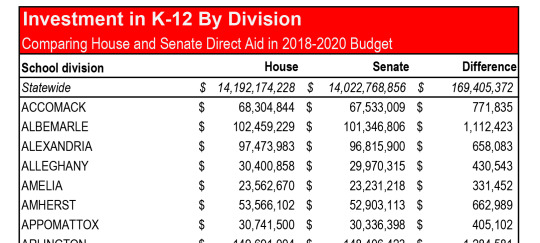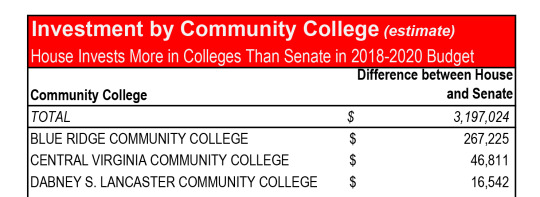February 28, 2018
Comparing House and Senate K-12, Higher Education Investments: Division by Division and College by College Breakdown
There is a chasm between the House and Senate versions of the state’s 2018-2020 budget, and that is largely driven by one decision: whether the state will go forward and accept federal funds to expand health care coverage to more low-income Virginians. Doing so will result in major savings that can be invested in our schools ($169 million) and colleges/universities ($100 million).
The decision on whether to expand Medicaid has a widespread impact across the budget because doing so will result in hundreds of millions in general fund savings when paired with a provider assessment. The total savings inked are $422 million in the governor’s proposal and $371 million in the House version.
The Senate version doesn’t include these savings, and because the state has to balance its budget, that means the Senate takes money out of areas across the budget to fill that hole.
We can clearly see the impacts of that decision on education.
Total direct aid going to K-12 school divisions is $69 million less in the Senate budget than the introduced budget. Meanwhile, the House increased state investment by over $100 million. That’s a gap of $169 million between the two proposals. (See the division by division impact by clicking the image below).

And, the differences are similarly glaring when we turn to higher education. The Senate version nixes $31 million from the introduced budget – most of which was for need-based financial aid for students – while the House keeps that financial aid assistance and adds another $69 million in investments to higher education institutions. (See the institution by institution impact by clicking the image below).

State budget conferees begin meeting today to work out the differences between the House and Senate budgets, with less than two weeks left until the legislative session is supposed to end. K-12 and higher education offer very real, concrete examples of the priorities the state can invest in, if ideological differences can be overcome. It is essential that lawmakers of all political parties and in both chambers come together to negotiate a deal on Medicaid expansion so that we can invest in priorities that grow strong communities like our schools.
Addendum table (3/5/2018) – See the estimated college by college impact for the Virginia Community College System by clicking the image below.

Category:
Education
